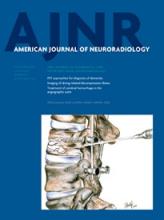The selection of candidates who are likely to benefit from reperfusion therapy has been a focus of research in acute ischemic stroke. This produced a number of paradigms to the conceptual approach and imaging of patients with acute ischemic stroke. These paradigms aim to establish the presence of a sizable salvageable brain tissue that justifies taking the risks of medical interventions to achieve reperfusion. This introduced the concept of mismatch: a clinically important difference between the brain tissue that is already infarcted (the core) and the tissue that is on its way to infarct if complete reperfusion is not rapidly achieved (the penumbra). The identification of mismatch has been a premise of acute stroke imaging either to allow the treatment of those with an onset time that is unknown or outside the conventional time window; or to help select candidates for endovascular therapies after intravenous thrombolysis.
The evidence to support improved functional outcomes with the use of a mismatch paradigm is yet to be shown in randomized clinical trials. Trials of intravenous thrombolysis1 or endovascular therapies2 have failed to show a significant difference in clinical outcomes between patients with acute stroke selected based on the detection of mismatch versus those selected based on typical clinical or imaging criteria. An important challenge is the dynamic and heterogeneous nature of ischemic stroke contrary to the static quality of many of the available imaging modalities. This makes the a priori prediction of tissue fate often flawed, especially when rapid reperfusion is increasingly achieved using contemporary endovascular devices. In addition, the distinction between the core versus the penumbra and the penumbra versus areas of benign oligemia may not be as well delineated as what is perceived by viewing the color-coded perfusion maps.3
An emerging paradigm that has received special attention in recent years is the assessment of the collateral circulation. These vascular channels are believed to sustain the penumbra for a relatively longer period of time and their extent is thought to be directly proportional to the volume of the penumbra. Patients with good collaterals have fared clinically better after thrombolytic or endovascular therapies compared with patients with poor collaterals even when reperfusion was achieved.4⇓–6 Traditionally, the collateral status was assessed in the acute stroke setting using conventional angiography.7 However, the advancement of noninvasive imaging techniques provided more readily available alternatives. Single-phase CTA assessment of leptomeningeal collaterals produced a number of scores, all of which concluded that better collaterals were associated with smaller infarct volume or better functional outcome than poor collaterals.8⇓–10 The sensitivity of single-phase CTA to the timing of image acquisition in relation to the bolus led researchers to develop techniques to provide dynamic collateral assessment. This produced time-resolved, CT-based collateral imaging techniques that used partial11 or complete12 brain coverage to assess the temporal filling of collaterals beyond an arterial occlusion. These data provided grounds for excluding patients with poor or no collaterals on multiphase CTA12 from the ongoing Endovascular treatment for Small Core and Anterior circulation Proximal occlusion with Emphasis on minimizing CT to recanalization times (ESCAPE) trial.
The role of MR imaging in collateral assessment relied on few techniques.13 The presence of distal hyperintense vessels on FLAIR imaging,14 believed to reflect good collateral status, corresponded to smaller core volume, favorable diffusion-perfusion mismatch, and milder stroke severity. Collateral assessment using arterial spin-labeling has shown good agreement with conventional angiography in patients with cervical or intracranial stenosis in the nonacute setting.15 Scattered reports described the potential utility of susceptibility-weighted imaging techniques in this context.13,16 It is hypothesized that the increased brain tissue demand for oxygen downstream from an occlusion leads to a higher concentration of deoxyhemoglobin in the capillaries and venous outflow channels leading to a susceptibility difference that discriminates these vessels from the adjacent brain.17 The detection of these channels is thought to signify the presence of penumbra.
In this issue of the American Journal of Neuroradiology, a mismatch paradigm based on the venous outflow estimation is used to define a susceptibility/diffusion (SWI/DWI) mismatch. This previously described paradigm18⇓–20 is objectively measured to assess the relationship between clinical outcome and an SWI/DWI mismatch in 54 patients with stroke treated with IV tPA. Automated venous SWI segmented maps were generated and compared with the contralateral side to calculate an asymmetry index. Patients with more than 1.75 asymmetry index and DWI volume of ≤25 mL achieved over 90% favorable outcome with recanalization. The SWI/DWI mismatch was a better predictor of functional independence than the PWI/DWI mismatch in this study.
Despite a number of limitations, many of which were acknowledged by the investigators, the study findings may have important future applications. Once the method to identify this SWI/DWI mismatch is simplified and accessible, studying this paradigm in past or ongoing large prospective cohorts will help advance the understanding of its significance and define its role in patient selection for reperfusion therapies outside the standard window or via the endovascular approach. Another interesting aspect will be to investigate any regional correlation of these venous outflow channels with penumbral tissue or the presence of robust collaterals. Once its validity is established, this imaging paradigm will face the practical challenges that all MR-based acute stroke techniques need to overcome21 in addition to the lack of evidence from a randomized trial supporting the improved outcomes of patients selected using penumbral imaging.2
Whether it is collateral-, tissue-, or venous outflow–based mismatch, the important question remains: which of these paradigms will be shown to predict improved functional outcomes? To achieve this, it will also need to be readily available, easily interpretable with minimal postprocessing, and able to be efficiently incorporated into the hyperacute stroke workflow to allow timely reperfusion. Finding the “perfect” mismatch is not easy after all!
References
- © 2014 by American Journal of Neuroradiology












